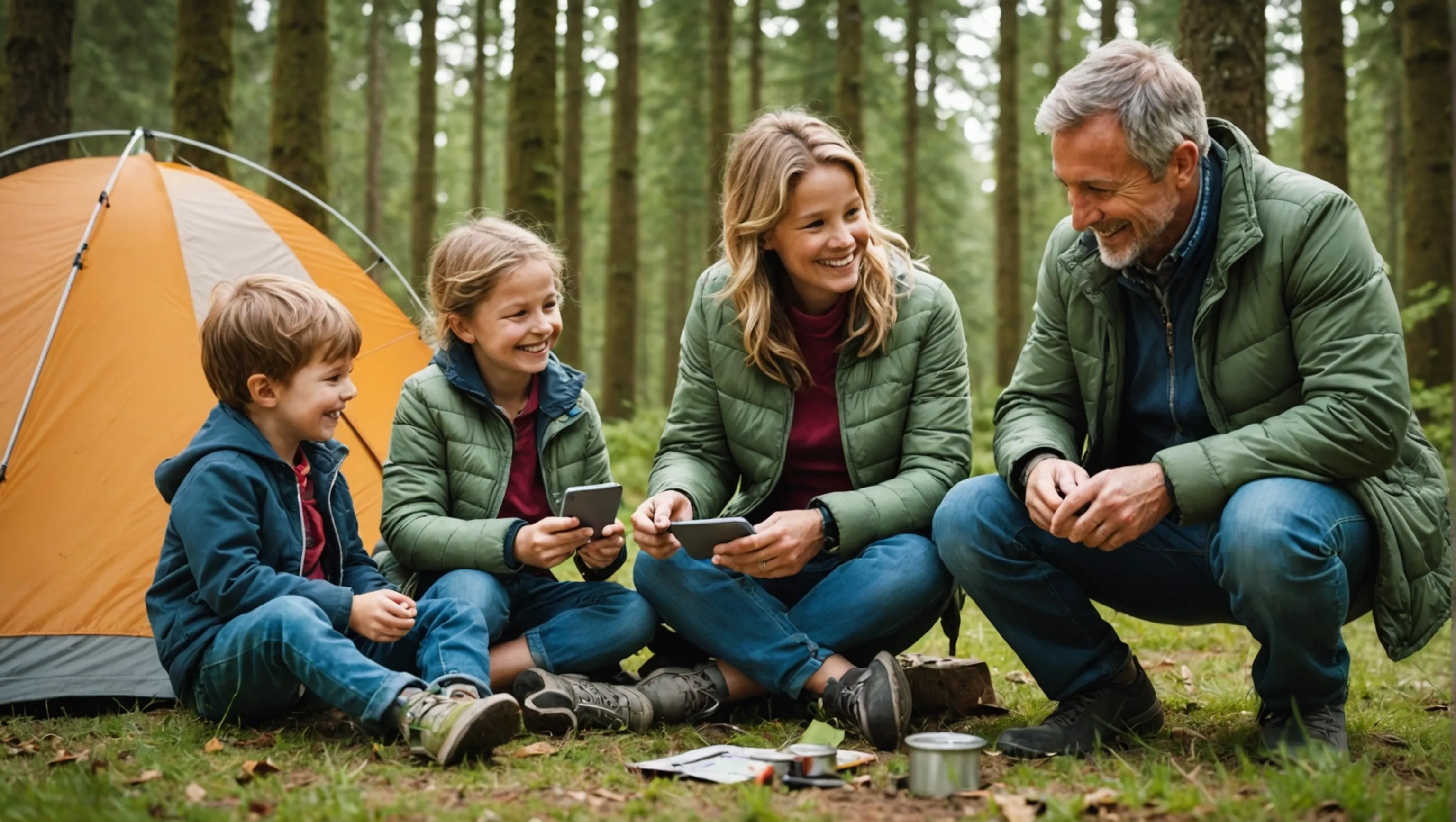Tips for Finding Free Campsites
 HHomeExchange
HHomeExchangeTips for Finding Free Campsites for Family Trips
Finding free campsites for family trips can be an exciting adventure. Start by doing thorough research on potential locations that suit your family's needs. Many families enjoy sites that offer amenities like restrooms and picnic tables, so make sure to check for these features.
Utilizing apps and websites dedicated to free camping can help streamline your search. Don’t forget to read reviews and check photos from other campers to ensure the site is family-friendly. Lastly, consider visiting local visitor centers for insider tips on hidden gems that might not be listed online.
Researching Campsite Locations
Researching campsite locations is a crucial step for families planning a memorable outdoor adventure. Start by identifying the type of environment your family prefers—be it mountains, forests, or lakesides. Websites like Campendium and FreeCampsites.net offer extensive databases of free camping locations along with reviews from fellow campers.
Consider using Google Maps to scout potential sites. You can explore satellite imagery to assess the terrain and nearby amenities, like water sources or hiking trails. Pay attention to user-generated photos to ensure the site matches your family’s expectations.
Another effective method is to consult local forums or blogs focused on camping. Many experienced campers share valuable insights about lesser-known spots that may not be listed on mainstream websites. Additionally, check for any seasonal considerations, as some campsites may close during particular times of the year due to weather conditions.
Don't forget to look into state and national park websites, which often list free or low-cost camping options. Some parks even have special programs for families, including ranger-led activities.
Lastly, consider reaching out to local camping groups or clubs. Many members are eager to share their experiences and recommendations, which can lead you to hidden treasures that are perfect for family outings.
Using Apps and Websites for Free Campsites
Using apps and websites to find free campsites can significantly enhance your family's camping experience. Several platforms specialize in helping campers locate free or low-cost sites, making the planning process easier and more efficient. Popular apps like iOverlander and Campendium provide user-generated content, including reviews, photos, and exact GPS coordinates for campsites across the country.
When using these apps, look for filters that allow you to specify amenities that matter to your family, such as bathrooms, fire pits, or pet-friendly options. This way, you can find a campsite that meets your needs without sifting through irrelevant listings.
Websites like FreeCampsites.net are also invaluable resources, offering detailed descriptions of various sites, including local attractions and nearby recreational activities. Many of these platforms allow users to leave comments, sharing their experiences and tips for future visitors.
Additionally, some apps feature offline maps, which can be incredibly useful when traveling to remote areas with limited cell service. This ensures you can access information about your chosen campsite even without an internet connection.
Lastly, don't overlook social media platforms, where various camping groups often share valuable tips and recommendations. Joining these communities can provide you with real-time updates on campsite conditions and other helpful advice from fellow family campers.
Checking Local Regulations and Availability
Before heading out, it’s essential to check local regulations and availability for free campsites. Each region may have specific rules regarding camping, such as fire restrictions, permit requirements, or designated camping areas. Visit the official websites of national forests or local parks to find the most accurate and up-to-date information.
Also, consider calling local ranger stations. They can provide insights on site availability, recent weather conditions, and any potential hazards. Being well-informed will help ensure a safe and enjoyable camping experience for your family.
Understanding National Forest and BLM Lands
Understanding National Forest and Bureau of Land Management (BLM) lands is crucial for families seeking free camping opportunities. Both of these public lands offer diverse landscapes and a variety of recreational activities, making them ideal for family trips. National Forests are managed by the U.S. Forest Service and provide access to forests, mountains, and lakes. BLM lands, managed by the Bureau of Land Management, often include deserts and open spaces, offering a different kind of adventure.
Camping on these lands is generally allowed, but it's important to follow specific regulations. Most National Forests and BLM lands offer a mix of developed campgrounds and dispersed camping options, the latter allowing you to set up camp away from established sites. However, dispersed camping may require you to be more self-sufficient, as amenities like restrooms and water sources may not be available.
Always check local guidelines before you go. Many areas have specific rules about campfires, waste disposal, and staying a certain distance from water sources. It's also a good idea to familiarize yourself with the Leave No Trace principles, which emphasize minimizing your impact on the environment.
Additionally, use resources like the National Forest Service and BLM websites to find maps and information about potential campsites, seasonal restrictions, and any alerts that may affect your trip. Understanding these lands can enrich your family's camping experience while ensuring you adhere to necessary regulations.
Exploring State Parks and Recreation Areas
Exploring state parks and recreation areas is a fantastic way for families to enjoy nature while finding free or low-cost camping options. State parks often offer a range of amenities, including picnic areas, hiking trails, and sometimes even swimming spots, making them ideal for family outings. Many state parks have designated campsites that are either free or available at a minimal fee, providing families with a safe and enjoyable environment to set up camp.
Before heading out, check the specific state park's website for information on camping regulations, availability, and any seasonal restrictions. Some parks require reservations, especially during peak seasons, so planning ahead is essential. Additionally, many state parks offer ranger-led activities that can enrich your family experience, from guided nature walks to educational programs about local wildlife.
In addition to traditional camping, many state parks allow for dispersed camping in certain areas. This option can offer a more secluded experience, allowing families to connect with nature away from the crowds. However, it’s essential to follow Leave No Trace principles to protect the environment.
Lastly, don't forget to take advantage of local visitor centers, which can provide maps, brochures, and expert advice on the best spots for camping and recreation. Exploring state parks and recreation areas can lead your family to hidden gems and unforgettable memories.
Talking to Fellow Campers and Locals
Talking to fellow campers and locals can provide invaluable insights when searching for free campsites. Campers who have been to the area often have firsthand knowledge of the best spots, hidden gems, and any potential challenges you might encounter. Engaging in conversations at campgrounds or local parks can lead to recommendations that aren’t found in guidebooks.
Locals can also offer tips on nearby attractions, safety concerns, and the best times to visit certain areas. Building a rapport with other outdoor enthusiasts can enrich your camping experience and ensure a smoother trip for your family.
Joining Online Camping Communities
Joining online camping communities is a fantastic way for families to enhance their camping experiences and discover free campsite options. These communities, often found on platforms like Facebook, Reddit, and specialized camping forums, provide a wealth of shared knowledge and experiences from fellow outdoor enthusiasts.
In these groups, you can ask questions, share your own tips, and learn about lesser-known camping spots that may not be widely advertised. Many experienced campers are happy to share their favorite locations, complete with details about amenities, local regulations, and what to expect. This can be particularly helpful for families looking for safe and suitable sites.
Additionally, online communities often host meetups or group camping events, which can provide a sense of camaraderie and support for families venturing into the great outdoors. Participating in these events allows families to learn from seasoned campers while enjoying shared experiences.
Don't forget to utilize social media for photo inspiration and travel blogs that focus on camping. Many influencers and bloggers provide in-depth reviews of campsites, along with personal stories that can help you gauge whether a location is family-friendly.
Finally, remember to be respectful and follow community guidelines when interacting online. Engaging positively can lead to lasting friendships and a richer camping experience, making your family's outdoor adventures even more enjoyable.
Asking for Recommendations on Social Media
Asking for recommendations on social media is an effective way to discover free campsites and gather valuable insights for your family's camping trip. Platforms like Facebook, Instagram, and Twitter provide ample opportunities to connect with fellow campers and outdoor enthusiasts. Here’s how to make the most of social media for camping recommendations:
Join Camping Groups: Look for groups dedicated to camping, hiking, or family outdoor activities. Post your inquiry and specify what you’re looking for, such as kid-friendly sites or areas with specific amenities.
Use Hashtags: Search for relevant hashtags like #FreeCamping or #FamilyCamping. This can lead you to posts where others have shared their experiences and recommendations.
Engage with Influencers: Follow camping influencers who focus on family adventures. They often share hidden gems and personal stories that can guide your decision-making.
Ask Friends and Family: Don’t underestimate your personal network. Post a question on your timeline or in a group chat to tap into your friends' experiences.
When asking for recommendations, be specific about your needs, such as location, amenities, and the type of camping experience you desire. This will help others provide tailored suggestions. Remember to express gratitude for any tips received; building these connections can lead to even more valuable insights in the future.
